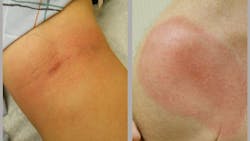A new study out of the Johns Hopkins Medicine Lyme Disease Research Center has revealed disparities in the diagnosis and treatment of Lyme disease between Black and White patients with the condition. Researchers say the data, which draws on participants’ medical histories, whether from Johns Hopkins Medicine or other institutions, highlights issues in the nation’s medical education on Lyme disease.
In the full article, published December 12 in JAMA Network Open, researchers say that Black patients were more likely to have advanced stages of Lyme disease when clinically diagnosed and also experience a longer time before receiving antibiotic treatment for the condition.
The cross-sectional study featured data from 1,395 patients with Lyme disease, all of whom were either clinic patients or research participants between 2008 and 2022 at the Johns Hopkins Medicine Lyme Disease Research Center. Researchers looked at participants’ medical records (both from Johns Hopkins Medicine or other institutions they were diagnosed at) to gather information on the nature of their Lyme disease diagnoses, including where, when, how and what stage of Lyme disease they experienced around the time of diagnosis.
Statistical tests showed a number of differences between Black and white Lyme disease patients. Over half (52.1%) of white patients presented only with a rash, compared to only 18.6% of Black patients.
The research team, led by Alison Rebman, MPH, calculated that Black patients had almost five times the odds of appearing in the clinic with advanced Lyme disease and had two times the odds of presenting without a rash or other telltale symptoms compared to White patients. The team also determined Black patients had a five-fold higher chance of waiting to receive antibiotic treatment for Lyme disease – 35 days compared to the White patient groups’ 7 days.

